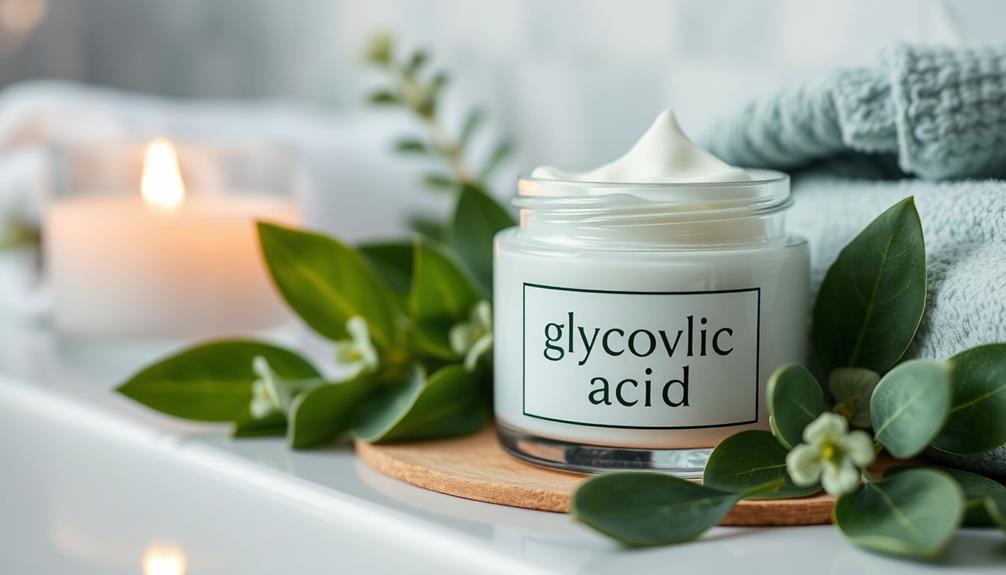Glycolic acid is the perfect solution for effectively combating hyperpigmentation. It helps in exfoliating and promoting cellular turnover, which encourages your skin to get rid of pigmented cells. By reducing melanin production, it gradually lightens dark spots, resulting in a more even skin tone. Regular use of glycolic acid, around 2 to 4 times a week, can significantly improve your skin’s texture and radiance. Additionally, it boosts collagen production to help address signs of aging. To achieve maximum benefits and minimize irritation, it is recommended to begin with lower concentrations and follow a proper application routine. If you want to learn more about using glycolic acid safely, there’s a lot more to discover!
Key Takeaways
- Glycolic acid inhibits melanin production, effectively targeting hyperpigmented areas on the skin.
- It promotes cellular turnover, helping to shed pigmented cells and reveal brighter skin.
- Regular use (2-4 times a week) leads to gradual lightening of dark spots over time.
- Glycolic acid improves overall skin texture, reducing fine lines and enhancing radiance.
What Is Glycolic Acid?

Glycolic acid, an alpha hydroxy acid derived from natural sources like sugar cane and pineapple, is a powerful exfoliant that helps your skin shed dead cells for a smoother, more radiant appearance.
Its small molecular size allows it to penetrate deeply, enhancing cellular turnover and promoting healthier skin texture. By breaking down the bonds between dead skin cells, glycolic acid reveals fresher skin beneath, contributing to a brighter complexion.
Additionally, incorporating essential oils like lavender and chamomile can complement your skincare routine by enhancing overall wellness, further supporting your skin's health.
You'll often find glycolic acid in various skincare formulations, including serums, toners, and peels, typically with concentrations ranging from 5% to 30%.
Regular use can lead to significant improvements in your skin, including a more even tone and a reduction in dark spots and hyperpigmentation.
The exfoliating properties of glycolic acid not only help in removing dead skin cells but also encourage the production of new cells, making your skin look revitalized.
If you're looking to enhance your skincare routine, incorporating glycolic acid can be a game changer.
Just remember to start with lower concentrations and gradually increase as your skin adjusts, ensuring you maximize the benefits while minimizing irritation.
How Glycolic Acid Reduces Hyperpigmentation

When incorporated into your skincare routine, glycolic acid effectively targets hyperpigmentation by inhibiting melanin production in overactive skin areas. This powerful chemical exfoliant penetrates deeply due to its small molecular size, promoting cellular turnover and helping to shed pigmented cells. As a result, you'll notice a gradual lightening of dark spots and improved skin tone over time.
Additionally, using essential oils for skin benefits can complement your glycolic acid treatment by providing soothing properties and further enhancing overall skin health.
Regular use of glycolic acid, ideally 2-4 times a week, can lead to significant improvements in pigmentation and overall skin radiance. By addressing hyperpigmentation, you're not only fading dark spots and melasma but also enhancing your skin texture. The exfoliation process helps reduce the appearance of fine lines, making your skin look more youthful and vibrant.
Incorporating glycolic acid into your routine is a strategic way to elevate your skincare game. You'll experience a more even skin tone while enjoying the added benefits of smoother texture and diminished fine lines.
With commitment and consistency, glycolic acid can transform your approach to tackling hyperpigmentation, leaving you with the clear, radiant skin you desire.
Benefits of Glycolic Acid for Skin

This powerful exfoliant offers numerous benefits for your skin, from promoting a brighter complexion to improving texture and reducing signs of aging. Glycolic Acid, a renowned chemical exfoliant, effectively dissolves the bonds between dead skin cells, encouraging the turnover of healthier layers beneath.
By incorporating it into your skincare routine, you can tackle hyperpigmentation, as it inhibits melanin production in overactive areas, leading to a more even skin tone and diminished dark spots. Additionally, the practice of self-care through effective skincare routines can enhance emotional well-being, similar to the empowerment through movement found in somatic therapy.
Regular use of glycolic acid can enhance your skin's texture and radiance, making it ideal for addressing issues like post-acne marks and sun damage. Studies show that consistent application results in visible improvements, contributing to the overall reduction of hyperpigmentation over time.
Plus, glycolic acid is suitable for all skin types, making it a versatile addition to your regimen. Furthermore, glycolic acid stimulates collagen production, which helps combat signs of aging and keeps your skin looking youthful.
To achieve the best results, aim to use this effective exfoliant 2-4 times a week, and watch your skin transform into a brighter, more uniform canvas.
Proper Usage and Application Techniques

To achieve the best results with glycolic acid, start by using a low concentration of 5-10% and gradually increase your usage as your skin adapts. Begin applying glycolic acid at night after cleansing to minimize any sun sensitivity. It is crucial to follow up with a hydrating moisturizer to prevent dryness and irritation.
Before diving in, always perform a patch test to assess how your skin reacts, especially if you have sensitive skin. If you experience any severe irritation or allergic reactions, discontinue use immediately.
Incorporate glycolic acid into your skincare routine with toners or serums specifically designed to fade dark spots and tackle hyperpigmentation for better absorption.
| Step | Recommendation |
|---|---|
| Start Concentration | 5-10% |
| Frequency | 1-3 times per week |
| Daytime Protection | Use broad-spectrum sunscreen (SPF 30+) |
Precautions and Skin Sensitivity Management

Glycolic acid can provide remarkable benefits for treating hyperpigmentation, but it's important to take precautions to avoid skin sensitivity.
Start with patch testing to determine how your skin reacts. Using a low concentration of glycolic acid (around 5-10%) is wise, allowing your skin to build tolerance over time. Gradually increase your usage frequency to 2-4 times a week as your skin adjusts.
Additionally, consider incorporating products rich in antioxidants, like rooibos tea benefits, to support skin health and combat oxidative stress during your skincare routine.
Apply glycolic acid products at night to minimize UV sensitivity, since the acid can make your skin more vulnerable to sun damage. During the day, always follow up with a broad-spectrum sunscreen of at least SPF 30. This step is vital for protecting your skin from increased sun sensitivity and preventing further pigmentation issues.
If you notice severe irritation, redness, or peeling, discontinue use immediately and consult a dermatologist. They can provide personalized advice on managing skin sensitivity and suggest alternative treatments that support collagen production without compromising your skin's health.
Frequently Asked Questions
How Does Glycolic Acid Reduce Hyperpigmentation?
Glycolic acid reduces hyperpigmentation by exfoliating your skin, encouraging dead skin cell turnover, and inhibiting melanin production. Regular use leads to a more even skin tone and diminishes dark spots over time.
How Long Does It Take for Glycolic Acid to Lighten Hyperpigmentation?
So, you thought a miracle cream would zap away hyperpigmentation overnight? Not quite! Expect noticeable changes in 4 to 12 weeks with regular glycolic acid use, but patience is key for that even skin tone.
How to Know if Glycolic Acid Is Working?
You'll know glycolic acid is working when you notice smoother skin texture, increased radiance, and a gradual fading of dark spots. Keep track of your progress with photos to see the visible changes over time.
What to Pair With Glycolic Acid for Hyperpigmentation?
Imagine applying glycolic acid with vitamin C; you'll notice brighter skin over time. Pairing these two boosts melanin control, while niacinamide soothes irritation. Don't forget sunscreen daily to protect against further pigmentation issues.
Conclusion
Incorporating glycolic acid into your skincare routine can be a game changer for tackling hyperpigmentation.
By gently exfoliating and promoting cell turnover, it helps reveal a more even skin tone.
Just remember, it's crucial to start slow and listen to your skin to avoid irritation.
With consistent use, you'll be well on your way to brighter, clearer skin.
So, don't throw in the towel; embrace glycolic acid and watch your skin transform!










